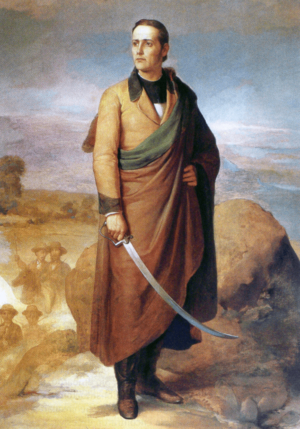Mariano Matamoros facts for kids
Quick facts for kids
Mariano Matamoros
|
|
|---|---|

A painting of Mariano Matamoros.
|
|
| Born | August 4, 1770 Mexico City, New Spain |
| Died | February 3, 1814 (aged 43) |
| Allegiance | Mexico |
| Service/ |
Revolutionary army |
| Years of service | 1811–1814 |
| Rank | Lieutenant general |
| Commands held | Mexican War of Independence |
| Battles/wars | Siege of Cuautla Battle of Lomas de Santa María Battle of Puruarán (POW) |
Mariano Matamoros y Guridi (born August 14, 1770 – died February 3, 1814) was a Mexican Catholic priest. He became a brave soldier and leader in the Mexican War of Independence. This war was fought in the early 1800s to free Mexico from Spanish rule.
Contents
Who Was Mariano Matamoros?
Early Life and Priesthood
Mariano Matamoros was born in Mexico City in 1770. He studied hard and earned a Bachelor of Arts degree in 1786. Later, he got a degree in theology in 1789. In 1796, he became a Catholic priest. He worked in several churches around Mexico City.
During this time, Matamoros started to believe in the idea of Mexico becoming independent. Because of these beliefs, the Spanish rulers put him in jail when the war for independence began. But he managed to escape from prison!
Joining the Fight for Freedom
After escaping, Matamoros joined the revolutionary army. He met José María Morelos, another important leader in the fight for independence. Matamoros joined Morelos's army on December 16, 1811.
Morelos quickly saw how talented Matamoros was. Just before the battle of Izucar, Morelos made him a colonel. He told Matamoros to gather his own soldiers. Matamoros went to the town of Jantetelco. There, he created a strong force of 2,000 men. This included cavalry (soldiers on horseback), infantry (foot soldiers), and artillery (soldiers who use cannons).
Key Battles and Leadership
Matamoros showed great skill during the Siege of Cuautla. This was a long battle from February 9 to May 2, 1812. Morelos was very impressed with Matamoros's abilities on the battlefield. He promoted him to lieutenant general. This made Matamoros the second-in-command of the entire army.
One night, Matamoros bravely broke through the Spanish siege. He was able to join another leader, Miguel Bravo, in Aculco. After the siege ended, the army continued its fight in Oaxaca. They surrounded Oaxaca on November 25, 1812.
Matamoros continued to win many battles. He defeated Manuel Lambrini in Santo Domingo Tonalá. He also won battles in San Juan Coscomatepec and San Agustín del Palmar.
Capture and Legacy
Matamoros was involved in the Battle of Valladolid in Michoacán. The Spanish army won this battle. After the defeat, on January 5, 1814, the army moved to Puruaran. During a difficult attack by Agustin de Iturbide, Matamoros tried to escape by crossing a river. But he was captured by a Spanish soldier named Eusebio Rodríguez.
Morelos tried to trade 200 Spanish prisoners to get Matamoros back. However, the Spanish rulers refused this offer.
Matamoros was removed from his role as a priest. He was put on trial for disloyalty to the Spanish government. He was executed in Valladolid, Michoacán, on February 3, 1814.
In 1823, Matamoros was honored as "Benemérito de la Patria," which means "Hero of the Homeland." His remains are now in the Independence Column in Mexico City.
Mariano Matamoros is remembered as a national hero in Mexico. Many places are named after him, including the Cuernavaca International Airport and the cities of Izúcar de Matamoros, Puebla, Matamoros, Coahuila de Zaragoza, and Matamoros, Tamaulipas.
Images for kids
See also
 In Spanish: Mariano Matamoros para niños
In Spanish: Mariano Matamoros para niños


